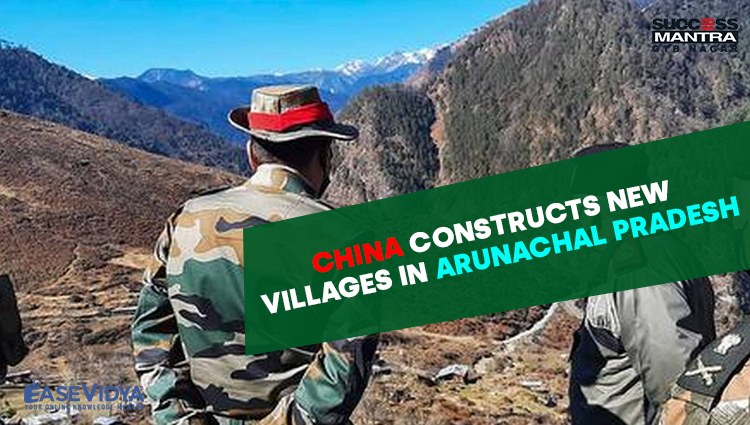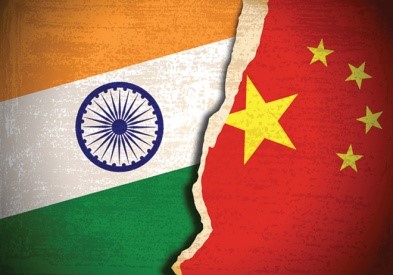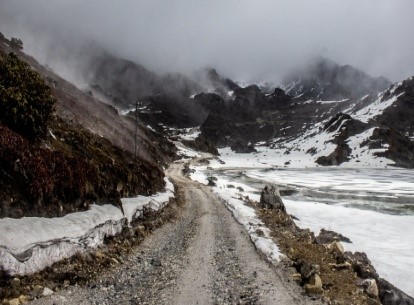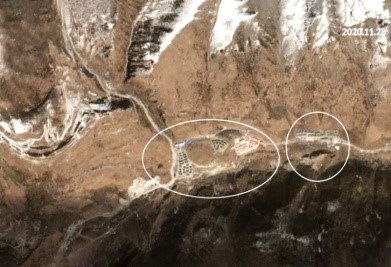
CHINA CONSTRUCTS NEW VILLAGES IN ARUNACHAL PRADESH
CHINA CONSTRUCTS NEW VILLAGES IN ARUNACHAL PRADESH

Recently, there have been reports of Chinese construction of three villages in Arunachal Pradesh 5 kilometres from the Bum La pass. Bum La Pass is one of the four officially agreed BPM (Border Personnel Meeting) points between the Indian Army and the People’s Liberation Army of China. Earlier in 2020, China had begun work on a strategically significant railway line that will link Sichuan province with Nyingchi in Tibet, which lies close to Arunachal Pradesh border.
NEW VILLAGE CONSTRUCTED LAST YEAR
The satellite images, dated November 2020, show that a full-fledged village has been built on the banks of the River Tsari Chu in the Upper Subansiri district of Arunachal Pradesh. The village is located a couple of kilometres across the Line of Actual Control (LAC). China had earlier built a permanent construction of military barracks in this area. The area has been under Chinese control since 1959. It is at least 2 km south (in Indian Territory) of the McMahon Line, which China doesn’t recognise. After the 1962 war, India stopped patrolling the area. China considers the McMahon Line illegal and unacceptable claiming that Tibetan representatives who had signed the 1914 Convention held in Shimla which delineated the McMahon line on the map were not having rights to do so. There are close to two dozen spots along the entire length of the Line of Actual Control (LAC) in all sectors where India and China do not agree on its alignment.
DIFFERENCE BETWEEN LAC AND LOC
Since the abrogation of Article 370, Pakistan has been regularly doing heavy firing on the Line of Control (LOC) and the International Border (IB). Prior to this, Indian and Chinese soldiers were fighting at the Line of Actual Control (LAC). India has many border-related disputes with its neighbours China and Pakistan. Some time these border issues led to the escalation of war like situation among these countries. As a citizen of India, we should know the borders of our country and the cause of disputes with neighbouring countries.
What is LOC: LOC or Line of Control is a live line with a lot of activities like firing and face to face interaction. It is clearly demarcated by the militaries. It denotes a kind of boundary separating parts of Indian UT i.e. Jammu & Kashmir; controlled by India and illegally occupied by Pakistan. The length of LOC is around 776-kilometers. Indian part (southern and eastern parts of the region) of LOC is known as Jammu and Kashmir which constitutes about 45 percent of Kashmir.
What is LAC: LAC stands for Line of Actual Control. It is a boundary between China and India. The concept of “Line of Actual Control” (LAC) came in a bilateral agreement in 1993, although there was no concrete settlement on ground positions between these two countries. The LAC separates Indian-controlled territory from Chinese-controlled territory. It is a big empty region and nearly 50 to 100 kms distance is maintained by the armies of India and China. The Chinese government considers LAC to be around 2,000 km while India considers the LAC to be 3,488 km long. LAC is divided into three regions: the western sector in Ladakh, the middle sector in Uttarakhand and Himachal Pradesh, and the eastern sector which spans Arunachal Pradesh and Sikkim.
CASE OF ARUNACHAL PRADESH

India's claim line is different from that of the LAC. It is the line seen in the official boundary marked on the maps as released by the Survey of India, including Aksai Chin (occupied by China). The state of Arunachal Pradesh is an ‘integral and inalienable’ part of India. In China’s case, LAC corresponds mostly to its claim line, but in the eastern sector, it claims the entire Arunachal Pradesh as South Tibet. The construction of the village has been seen by analysts as a move to bolster China’s claim to the area, and part of a broader recent push by China to build civilian settlements in disputed frontier areas, which it has also done with Bhutan.
IMPLICATIONS ON INDIA
• Security Concerns: A village near the border will largely improve the efficiency and convenience of military personnel and material transportation and logistical supplies in the border area. In situations of direct standoff near Arunachal Pradesh border, as was seen during Doklam or recent Ladakh standoff, China might be at an advantageous position.
• Doklam Issue: Indian troops intervened to block the path of Chinese soldiers engaged in building road-works on the Doklam plateau of Bhutan’s territory that Beijing laid claim.
RECENT STEPS TAKEN BY INDIA

India will spend 10% funds of the Border Area Development Programme (BADP) only to improve the infrastructure along the China border. The Border Roads Organisation (BRO) constructed the Daporijo bridge over Subansiri river in Arunachal Pradesh in a record span of just 27 days. It links roads leading upto the LAC between India and China. Recently the Defence Minister virtually laid the foundation of a tunnel at Nechiphu in West Kameng district of Arunachal Pradesh. It will shorten travel time for troops till the LAC through Tawang, which China claims to be its territory. The BRO is already constructing an all-weather tunnel under the Se La pass in Arunachal Pradesh which connects Tawang to the rest of Arunachal and Guwahati. The state government of Arunachal Pradesh has advocated selection of 10 census towns along the India-China border as pilot projects for infrastructure development in order to stop people living along its international borders, specifically with China, from migrating to faraway urban centres in the State. Recently, the Defence Minister inaugurated the Sisseri River Bridge located at lower Dibang Valley in Arunachal Pradesh connecting Dibang Valley and Siang. In 2019, the Indian Air Force inaugurated resurfaced runway at India’s easternmost Village-Vijaynagar (Changlang district) in Arunachal Pradesh. In 2019, the Indian Army conducted exercise ‘HimVijay’ in Arunachal Pradesh and Assam with its newly created Integrated Battle Groups (IBG). Bogibeel Bridge, which is India’s longest road-rail bridge connecting Dibrugarh in Assam to Pasighat in Arunachal Pradesh was inaugurated in 2018. It will facilitate quicker movement of troops and equipment to areas near the India-China border.
CONCLUSION
India needs to be vigilant enough for any new development in China near its border to protect its interests efficiently. Further, it needs to build robust Infrastructure in difficult border areas in its territory to ensure movement of personnel and other logistical supplies in an efficient
manner.












0 Comment